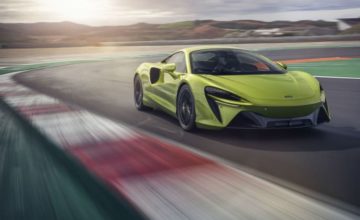Automobili Lamborghini S.p.A, commonly referred to as Lamborghini is an Italian automaker. The company was created by Successful Business man Ferruccio Lamborghini in 1963, with the objective of producing a refined grand touring sports car to compete with established offerings from competing companies like Ferrari.
The first models were released in the mid-1960s, and were noted for their classy looks, power, and comfort. Lamborghini gained world popularity in 1966 for the Miura sports coup?, which established mid-engine design as the standard layout to which high-performance cars of the era would try to reach. After a decade of rapid growth, the company faced a financial crisis, the company in the mid-1970s, as sales plunged in the wake of the 1973 world financial downturn and oil crisis. After going through bankruptcy and three changes in ownership, Lamborghini was finally bought by the Chrysler Corporation in 1987. The American company failed to return the automaker to a profitable status and sold it to Indonesian interests in 1994. Lamborghini’s lack of success continued through the 1990s, finally the company was sold in 1998 to Audi, a subsidiary of the Volkswagen Group, a German automotive concern. Audi’s ownership marked the beginning of a period of stability and increased productivity for Lamborghini, with sales increasing through the early 2000’s peaking in record sales in 2007 and 2008. The world financial crisis in the late 2000s negatively affected luxury car makers worldwide, and saw Lamborghini’s sales drop back to pre-2006 levels.
Assembly of Lamborghini cars unlike other cars in the world continues to take place at the automaker’s home in Sant’Agata Bolognese, Where the car parts and main assembly line sit side by side. Fewer than 3,000 cars roll off the production line each year. The company currently offers two variations of a single model, the V10-powered Gallardo coup? and roadster. The flagship V12-powered Murci?lago coup? and roadster were discontinued at the end of 2010, with a successor expected in 2011.
Other popular car makes include the Lamborghini Revent?n (Spanish pronunciation) is a mid-engine sports car that was released into the market at the 2007 Frankfurt Motor Show. This car is the most expensive Lamborghini road car to date.
Lamborghini 400GT is the name given to two gran tourismos, the first 400GT, commonly referred to as the 400GT or 400GT Interim, This car was essentially the older of the two. The 350GT featuring an enlarged, V12 engine, that can put out power as high as 320 bhp (239 kW). Twenty-three of these cars were built, with three featuring aluminium bodywork.
The second 400GT, commonly known as the 400GT 2+2, had certain changes such as a longer wheelbase, different roofline, and minor sheet metal changes compared to the 350GT and first 400GT. It was first shown to the public at the 1966 Geneva Auto Show. The larger body shape enabled the +2 seating to be installed in the rear, where the 350GT only had room for luggage or +1 seating. The bodywork was designed by Carrozzeria Touring. Other features of the 400GT 2+2 were a Lamborghini designed gearbox, with Porsche style synchromesh on all gears, which greatly improved the drive train. A total of 247 units of the 400GT 2+2 were built from 1966 to 1968, when it was replaced with the Islero. A special, one-off version called the 400GT Monza was built by Neri and Bonacini, who had previously worked on the 350GT.
Lamborghini Aventador LP700-4] is a two-door, two-seat sports car which is set to replace the Murci?lago in the Italian automaker’s lineup. It was launched at the 2011 in Geneva at the Geneva Motor Show on March 1. It features a brand new 6.5 liter V12 engine, producing 691 hp (515 kW). It was designed by Filippo Perini of Lamborghini Centro Stile under the direction of Lamborghini chief of design Manfred Fitzgerald.
Performance is set to be: 0-62 mph (0-100 km/h) in just 2.9 seconds and a top speed of 217 mph (350 km/h). Lamborghini says that the Aventador is two generations ahead of anything else on the market, using Formula One-style suspension and a lightweight carbon fiber panels.
The name comes from Lamborghini’s traditional fascination with the world of bull fighting. In this case, the Aventador was named for a Spanish fighting bull from the breeding stables of the sons of Don Celestino Cuadri Vides. All with the signed number 32 on his hide, Aventador gained fame in 1993 in the town of Zaragoza, Spain after a notably spirited, bloody and violent battle with a torero that earned it the “Trofeo de la Pe?a La Madro?era” for its courage.
Its transmission, a single-clutch 7-speed semi-automatic, is built by Graziano Transmission. Despite being single-clutch, gear-shifts are accomplished in 50 milliseconds.
In all there will be limited to 4000 units although 4099 Murci?lagos have been built to date. The moulds used to make the carbon-fiber monocoque are expected to last 500 units each and only 8 have been made.
The last and most well known of the cars lineup is the Lamborghini Diablo which is a high-performance mid-engine sports car that was built by Italian automaker Lamborghini between 1990 and 2001. It was the first Lamborghini capable of attaining a top speed faster than 200 miles per hour (320 km/h). After the end of its production run in 2001, the Diablo was replaced by the Lamborghini Murci?lago.
History of development
At a time when the company was financed by the Swiss-based Mimram brothers, Lamborghini began development of what was code named Project 132 in June 1985 as a replacement for the Countach model. The brief stated that its top speed had to be at least 315 km/h (196 mph).
The design of the car was out sourced to Marcello Gandini, who had designed its two predecessors. When Chrysler Purchased the company in 1987, this providing money to complete its development, its management was unimpressed with Gandini’s designs and commissioned its design team in Detroit to execute a third extensive redesign, smoothing out the trademark sharp edges and corners of Gandini’s original design, and leaving him famously upset. In fact, Gandini was so disappointed with the “softened” shape that he would later realize his original design in the Cizeta-Moroder V16T.
The car became known as the Diablo, which carrying on Lamborghini’s tradition of naming its cars after breeds of fighting bull. Diablo was named after a ferocious bull raised by the Duke of Veragua in the mid 19th century, famous for fighting an epic battle with ‘El Chicorro’ in Madrid on July 11, 1869. In the words of Top Gear presenter Jeremy Clarkson, the Diablo was designed “solely to be the biggest head-turner in the world.”



